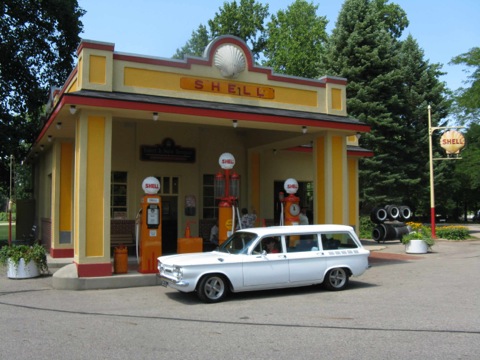
One of the things that many people do to make their Corvairs faster or more distinctive is to install different wheels and tires, a task that can be very frustrating if you just try to put on whatever seems to fit. This article originally appeared as a four month series in the Hot Air Mail (Northern Virginia Corvair Club's newsletter) and is an attempt to help Corvair enthusiasts properly fit non stock wheels and tires, whether new or used. Thanks to the members of the Northern Virginia Corvair Club for their input in writing this article, and the members of Virtual Vairs for many of the additions and refinements.
Since so many folks change the wheel and tire combination on their street cars, I've now broken this page into two sections, street and competition.
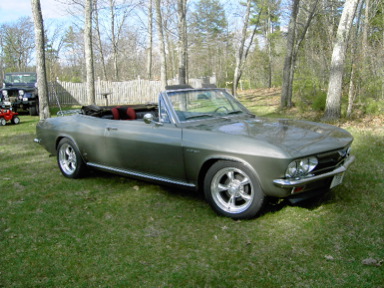
Let's look at street tires first. I use and recommend only radial tires, so that's what this information covers. The size radial closest to a stock 6.50-13 bias ply is 185/80R13, but unless you have a factory stock show car, you may wish to use a different size. Most major tire manufacturers make several different types of tires, so to decide which of these types and in what size it helps to realistically decide how much money you want to spend and what kind of use you'll put them to. Answering the following questions usually helps:
The following dimensions will affect your decision in various ways, so keep the following in mind:
Width - a wider tire will generate somewhat more grip but is more likely to hydroplane, and may hit various parts of the car if the wheel size is not optimum. Also, if you want tires wider than 205mm, you must get wider wheels.
Profile - a lower profile tire has more grip (because it deflects less), but the ride will be stiffer. See these photos for what's going on.
Speed rating - generally unnecessary on U.S. roads, but higher speed ratings are an indication of a more sporting tire.
Wheel diameter - if it isn't 13 inches, you will need non stock wheels.
Overall height - This affects the gearing, speedometer, and ride height. Note that the height of the tire off the car is not the same as the rolling diameter, since loading, construction, and air pressure affect the height. Although you can't easily measure this dimension, you can find often find it as part of the tire specifications, expressed a couple different ways:
If you'd like to measure a tire, you need to have it mounted and on a car. Make a mark on the bottom of the tire, roll the car through ten revolutions and measure the distance the car traveled. Divide by ten, then two times pi (6.28) and you'll have the loaded radius.
If you're buying new tires, bear in mind that there is some tolerance in the specification for a given size, you should check with the tire dealer to be sure what the real dimensions are of the tires you want. Also, after seeing the many sizes that folks have used and ended up with accurate speedometers, it is obvious that although stock speedometers may have been correct when new, now that they are over forty years old they are likely to be a bit off. The tires that produced good results with my car are technically a bit short. The upshot of this is that once you have selected your tires, you should do an odometer check of at least ten miles, and if possible a speed check as well (one mile per minute at 60 MPH, do three or more miles if possible).
Having said all that, I surfed over to The B.F. Goodrich site to come up with some examples of tires that would work well on Corvairs. They have data sheets for all of their tires there, I used the specs from the Radial T/A here, other models will be a bit different. You should be aware that the sizes are a range, so it's a good idea to get the data sheet if you can, especially if you have chosen a size near the limit of what will fit. Unfortunately, BFG doesn't offer a 13" Radial T/A that will work well, these are 14, 15 and 16 inch:
Of course, if you use one of the sizes above, this leads to the question "what car has wheels that fit my Corvair?". If you have an early, the answer is pretty easy - many 70's and 80's Japanese rear wheel drive cars have the same bolt pattern and approximately the correct backspacing. For lates, it's a good news/bad news answer. The good news is that the lates use the common Chevy RWD pattern. The bad news is that the backspacing is different from pretty much every one of those cars, so those wheels end up outboard of stock.
Further, I'm not aware of anyone who is making alloy wheels specifically to fit Corvairs. So, the short answer is you should measure before buying the wheels you plan on putting on your 'Vair (early or late). This is not to say that you can't find wheels which will fit, just that you should not buy a specific wheel unless you're sure it will fit first.
Let's start with a description of the various dimensions that are used to measure a wheel:
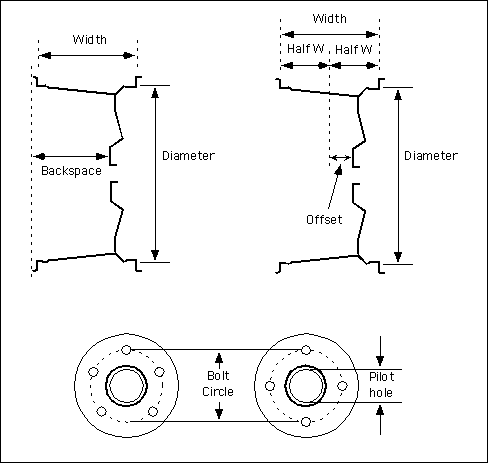
Diameter - Vertical dimension of the wheel, measured where the tire's bead seats. All Corvair cars came with 13" wheels as stock, FCs are 14".
Width - The distance between the inner lips of the rim, where the tire beads seat. All Corvair cars came with 5 1/2" wide wheels, FC wheels are 5" wide.
Lug Pattern - This is the number of lugs used to hold the wheel on, and the diameter of a circle drawn through the center of the lug holes in the wheel. Earlies use 4 lugs on a 4 1/2" circle (4 x 4 1/2"), lates and FCs use 5 lugs on a 4 3/4" circle (5 x 4 3/4"). A list of possible donors is near the bottom of this page, if you're looking for info on swapping wheels for another type of car, I also have a fairly complete list of wheel lug patterns.
Center Hole Diameter - The hole in the center of the wheel that the hub fits through. Earlies are 2 5/8", lates are 2.8".
Backspacing - The distance from the inside of the rim to the point where the wheel contacts the brake drum. All car 5 1/2" wide wheels have a backspacing of 4 1/4". FC wheels have a backspace of 3 1/2". For reference, more backspace moves the wheel further in the wheelwell, less backspace brings it out. Maximum backspace for an early with 15" wheels is 5", late is 5 1/4". For FCs it's a little more complicated, 14" wheels are limited to the stock backspace because a deeper set wheel will hit the tie rod. I have not yet tested larger diameter wheels on an FC.
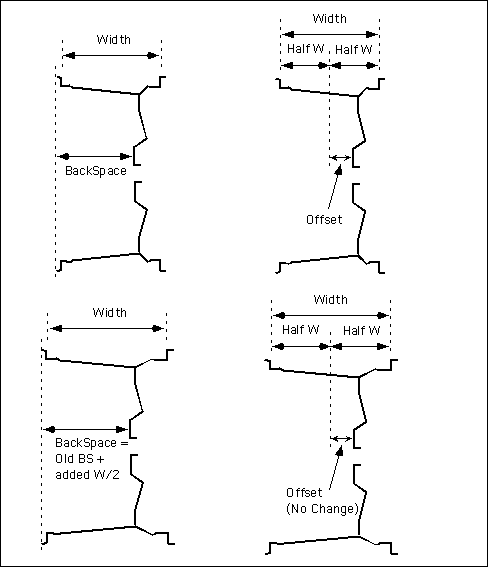
Offset - If the wheel is centered in and out relative to the face that contacts the drum, then it's zero offset. If the wheel is in or out relative to the mounting face, then it has offset. The stock Corvair car wheel (early or late) is offset 1" inboard (source: Chevrolet Engineering Features, courtesy Larry Claypool).
Note: I prefer using backspace to offset, since there is some difference of opinion as to which way is "negative" or "positive" offset - the current catalogs show "positive" as the mounting surface of the wheel being closer to the outside of the rim than the inside. I will generally use backspace.
Since the common lug pattern for GM RWD from the 50's to the present is 5 x 4 3/4", lots of different wheels will bolt onto a late model. The pattern for earlies is uncommon among U.S. makers, but is common on RWD Mazdas, Nissans, and Toyotas. 14", 15", 16" or even 17" diameter wheels will fit on all Corvairs, but the width on earlies can't exceed about 7" because of two points of interference. On the front, the end of the steering arm comes close to the sidewall, and on the rear, the upper shock mounting point is close to the sidewall. Fitting quick steering arms may help the clearance problem up front, while some careful trimming may increase clearance in the rear.
Lates can easily handle up to 7" wide wheels in the front, with up to 8" (!) wide in the rear with the correct backspacing. Even wider will fit in certain sizes, but you will need to alter the backspacing to move the wheel out somewhat (less backspace), and perhaps roll the inside edge of the fenders. On the inside you should also check the steering arm in the front and the protruding threads on the rear suspension's toe control links for clearance.
When fitting new wheels the rim should ideally remain positioned in and out relative to the hub as close to stock as possible (yes, tires sticking way out from the fenders are a bad thing), which can be determined by measuring the backspacing. This dimension is probably the most important, because if the tire is not located correctly the wheel bearings will wear prematurely due to uneven loading, the tires may hit the inside or outside of the fender or other components, and the car will likely dart around when you hit a bump.
That said, a late model Corvair has a bit more clearance on the outside of the tire than the inside, and with 13" wheels you really can't add much at all to the inside of the rim. Fortunately the dimension also allows some tolerance, you can consider +/- 1/2" to have no effect at all on the handling. When sizing a wider wheel, add half of the additional width to the stock backspacing to arrive at the backspacing for the new wheel. If you want to stuff really huge wheels and tires under your 'Vair, it's best to jack the car up, remove the springs so that the suspension can be moved throughout its range, then bolt on a set of stock wheels and tires and measure the actual clearance available. The center hole diameter is fairly common to many cars, but should be checked because this helps align the wheel on the hub, and of course if the hole is too small the wheel won't go on the car. If the hole is too large, it's not especially critical, it does not appear to compromise the strength (in other words, yes, the lugs are strong enough to hold the car up, even in competition).
If you do want centering rings, here's some info from Kent Sullivan:
I just had some concentric rings made. They do the job well. However, they had a "lip" on them as made by the manufacturer because they were intended for aluminum mags. I used a Dremel bench sander to take off the lip, which left me with a cylinder, no lip. I was able to do this because the rings I chose are composite, not metal.
The wheels I had these made for use with are steel by Wheel Vintiques. OD of the late Corvair car hub is 2.8" so I had the ID of the ring made to fit that. The ID of the wheel is 3.19" so I had the OD of the ring made to fit that.
The rings came from a place that Seth recommended... I dug around a bit and found the info Seth provided to me earlier:
Prestige Wheel Accessories, Inc.
7575 Reynolds Circle
Huntington Beach, CA 92647
714-362-8500 voice
714-362-8008 fax
contactus@prestigewheel.com
http://www.prestigewheel.com/
They stock some common sizes but in all likelihood you'll need to have them made in a non-stocked size. You should ask them if they can make them as as smooth cylinders with no lip for steel wheel use; otherwise you'll have to remove that yourself.
--Kent
To put this info together, here are a few examples of wheel and tire combinations. All of the street tire options listed keep the overall diameter about the same as stock, so your effective gear ratio stays the same, and your speedometer will be as accurate as it was before. First off, you have to decide if you want to keep your stock wheels. If so, there are really few 13" tires made today that will work:
You may find 175/80-13 or 205/60-13 sizes, but these are not optimal for a street Corvair. 175/80-13 tires have a low load rating for the rear of a Corvair, and the 205/60-13 is very short.
Caution: You may accidentally find trailer tires when searching by size. Do not use trailer tires. They are not made for the cornering forces generated in a car. Make sure the tires you buy are designated for passenger vehicles.
If you're willing to buy new wheels, the options for tire sizes open up, plus you can vary the looks of the car. For street use, most folks like either 14" or 15" wheels with either 70 or 60 series tires, which give better cornering performance while still having a good ride.
Early: Good interchanges for early models are 6" wide wheels from a '70 - '78 Datsun Z or an '83 - '87 "AE86" RWD Toyota Corolla. The Z wheels are a little outboard, the backspacing for a 6" wheel should be at or just over 4" (ideal would be 4 1/2") the Toyota wheels will be a better fit, up to 7" wide will work. Good 14" tire choices are 185/70-14, 195/70-14, or 205/70-14. 185/60-15 and 195/60-15 sizes should work well with 15" wheels.
Our wagon had a set of XXR brand wheels meant for the AE86 Corolla. Dimensions are 15x7", 15 mm offset, 4.75" backspace. Mounted on them is a set of BFG 205/55-15 G-Force Sport tires. This just barely fits without modifying the wheel wells. I did have to grind the heads off the rivets on the front brake drums.
Unfortunately that set was stolen, so far the time being I have 15x6" Datsun 280ZX Turbo wheels on it with 205/60-15 tires. A key detail in using the Datsun wheels is choosing proper lug nuts, the usual mag nuts don't quite fit. I purchased a set of nuts with .73" shanks, .60" depth, and integral washers that have the Corvair 7/16" thread size. The only minor issue is they use a 13/16" instead of 3/4" wrench. I found them by searching for "7/16 mag lug nuts .73 shank", and bought them from an ebay seller in Michigan.
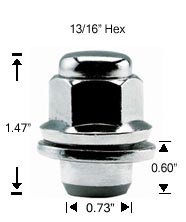 |
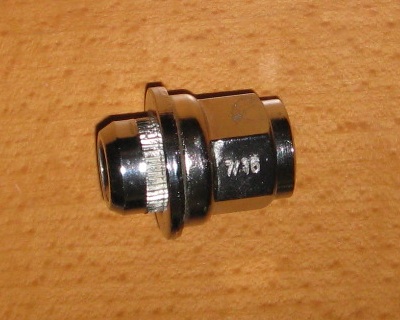 |
Late: Many people have used a variety of 14", 15" and 16" wheels on late model Corvairs, one of the most popular donors is the Camaro. Although these wheels do bolt up, you must be careful with the backspacing, especially on those 7" wide or wider. I suggest using the 6" wide versions, since they mount a 205 very nicely and are easier to find in a backspacing of 4", which fits the late Corvair well. You will need at least 4" of backspace on a 7" wide rim, and 4 1/2" is much better for steering feel and clearance.
A popular choice is the 15x7 from the '82-'92 Camaro & Firebirds. These wheels have 4 1/4" backspace, which puts them about 3/4" outboard of ideal. The first effect is the car will be somewhat more twitchy, especially when hitting a bump. Second, you are limited to a tire no larger than 205/60-15, or they will likely interfere with the fender lips (Seth Emerson wrote a nice tech tip on rolling fender lips which appears in the CORSA Tech Guide). Finally the donor cars used a metric lug nut which cannot be used on a Corvair. The optional 16x8 inch Camaro IROC wheel can also be mde to fit, Bruce Schug wrote this note about fitting the wheels and correct lugnuts.
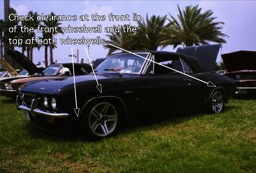
Click to see a larger view of Mike Seversin's lovely '65 Corsa convert with IROC 16x8's and 225/45-16 tires.
Note the places to check for rubbing.
Personally, I've been very happy using 205/60-14 tires on 14" x 6" Chevy steel wheels on the front, and 245/60-14 tires on 14" x 7" Chevy steel wheels rear. Backspace is pretty close, 4" (ideal would be 4 1/2") front, 4 1/4" (optimum 5") rear. With these, any road imperfections are noticeable, but the ride isn't especially harsh and the increase in grip is quite large. This front tire size gave me an accurate speedometer too, although it is technically a bit short.
As with choosing street tires, there are some questions you'll need to answer when choosing tires for competition:
For SCCA Stock and Street Prepared autocross use, I highly suggest you acquire a set of "R" tires if you're planning on running more than one or two events per year. The reasons are:
Selecting a set of tires for competition in some ways is easier than selecting street tires, especially if you are going to have two sets of tires for the car. In fact, that is the first decision you will need to make - do you want to have a second set of tires, and if so, do you want to change them at home or at the event.
If you elect to have a second set of tires and are willing to change them at the event, you will need to take a jack and lug wrench, plus you'll need to stuff them in the back seat and trunk, limiting space for other things or passengers. The up side to doing this is that you can choose tires without worrying about ground clearance, speedometer error, or highway gearing considerations. Another possibilty, and an added expense, is to get a small utility trailer and build a lockable enclosure on it. This is a very popular choice among autocrossers with street legal cars.
Your other choice is to run your race tires on the street, either all the time or just to events. This worked well for me, as I don't drive the car much (~5000 miles per year), and our events are generally about 30 miles or less away. This way poses limits in that you can't use really short tires because of ground clearance problems and you'll be limited in highway cruising speed - don't forget that a stock Corvair turns about 3500 RPM at 70.
Here's a point that's worth mentioning - lower is better when it comes to handling (you can read more about why in Fred Puhn's book on handling). So the best choice for a Corvair is usually considered to be a 13" wheel with the lowest profile, widest tire you can put on it, which is a 215 or 225 width 50 series. Shorter tires will also give you a shorter overall gear ratio, so the car will accelerate better. Finally, a smaller tire is (obviously) lighter, reducing both your unsprung weight and rotating mass.
The downside is that wide 13" wheels are uncommon, so you'll have to either find a used set from another Corvair racer, or have some made. 14" and 15" wheels are pretty common, and with a 50 series tire you won't have to worry much about clearing the fenders. Either of these setups will probably be too short for the street, so you should plan on two sets of tires if you choose one of these options.
If you want to do what I did, my autocross setup is a set of 15" x 6 1/2" SenDel mags with 5 1/4" backspacing, with 225/50-15 BFG Comp T/A R-1 road race tires. These fit very nicely, with no interference. In fact, they are backspaced a bit too much, the ideal would be about 4 3/4". I suspect these wheels are actually for a 4WD Chevy S-10 Blazer, since the backspace on a stock wheel from one measures about 5 1/2".
For those of you competing on slicks or with shaved DOT tires it's worth thinking about a set of rain tires, especially if you're doing track events. To help with the expense, you might look at a tire that's a bit less expensive and use them for some testing as well. Don't forget that tires age, you don't want to try to use the same tires for more than a season if possible, so run the rain tires some of the time to save your dry set.
The factory recommended tire pressure settings were selected to dial in understeer and provide a comfortable ride on bias ply tires being the important conditions. Although radial tires are much more forgiving, you should still maintain a pressure differential of 8 to 10 pounds front to rear, but you can improve the responsiveness and handling by raising the tire pressure up to about 27 front, 35 psi rear for street use (don't exceed the maximum tire inflation on the sidewall). Autocross use is a bit trickier, as the construction of the tire has an effect on the amount of pressure in the tire. In short, there are now three types of "Street" tire:
The first are tires to drive around on all the time, these are designed to give a reasonable service life (~50k miles), good all weather performance, and perhaps a sporting amount of grip. The BF Goodrich Radial T/A, Goodyear Eagle Aquatread, etc. fall into this category. These tires have a relatively soft sidewall which gives them a nice ride, but they unfortunately allow the tire under hard cornering to try to roll under the rim, meaning you're now cornering on the sidewall instead of the tread. Bad plan.
The proper solution is to get a set of competition tires (see below) which don't do this. But if you're just trying out the sport, there is a band aid fix - more air. The additional pressure will stiffen the sidewall, which will help the handling, up to the point where the contact patch is so much smaller that the tire slips anyway. Generally, a 5 to 10 psi increase works well, *but* you may need to increase the front and rear tires different amounts to make the car well-balanced.
The second group are "R" tires, that is tires which meet the letter of the DOT regulations for street tires, but are really meant for competition use. Goodyear's Eagle VR-S, Yoko AD08-R, and Hoosier's R-6 are examples of this breed. These tires have the sidewall stiffened to avoid the tire rolling over on its shoulder during hard use, so using the 27/35 tire pressure is still a good baseline. These tires will respond to pressure changes differently, you may need to lower pressure to get more traction. I suggest using a pyrometer with these tires, but chalking will work to start.
With the advent of the new SCCA "Street" and "Street Touring" classes, there are now tires which come very close to the concept of a tire you can drive on the street that will also work at an autocross. The Dunlop ZII and BFG Rival are examples of this type, with a minimum tread wear rating of 200. As with the DOT race tires, start at 27/35 and go from there.
Here's how to "chalk" tires to find a good pressure, from a post by Mike Lukacs to the autocross list (Team.Net):
The classic method of determining correct tire pressures for autox is as follows:
- A) raise your tire pressures to ~10 lbs above mfg recommended pressures to start.
- B) mark the outside tread/sidewall corners of each tire with 3 or 4 patches of white shoe polish (sneaker polish) spaced around the tire.
- C) after your first run, check the shoe polish patches to see if you are using the whole tread width, but not rolling over onto the sidewall too much.
- D) if the shoe polish is getting rubbed off of the sidewall area, raise that tire's pressure by 1 or two pounds. If the shoe polish is NOT getting rubbed off of the outer tread area, lower that tire's pressure by a pound or two.
- E) repeat steps B, C, D, until you are happy.
Caveat: this method is only approximate, a tire pyrometer to measure the evenness of temperature across the tread is better.
Note: Don't forget to go back to your normal street pressures before you leave the event! [BB]
Since many folks want to know what to shop for online, at swap meets, junk yards, etc., here is some info which might be helpful.
Earlies have 4 lugs on a 4 1/2" (114.3mm) bolt circle. Other cars with that 4 on 4 1/2 pattern are:
| Acura Legend | '86 to '90 |
| Chevy Nova, Chevy II | '60 to '64 |
| Chevy Sprint | '85 to '87 |
| Buick Special, Olds F-85 | '61 to '63 |
| Datsun/Nissan, most RWD models | to '89 |
| Dodge Colt | '79 to '92 |
| Ford Falcon, Mustang (6 cyl) | '60 to '73 |
| Ford Granada, Maverick | '81 to '83 |
| Hyundai | all years |
| Infiniti G20 | '91 - '96 |
| Infiniti M30 | '90 - '92 |
| Mazda 323 | '86 to '89 |
| Mazda 626, RX7 | '83 to '87 |
| Mazda GLC | '81 to '85 |
| Mazda RX-7 GSL/SE | '84 to '88 |
| MGA, MGB, MGC | all |
| Mitsubishi, most 4 lug | all years |
| Nissan 240SX | all 4 cyl |
| Nissan Altima | '93 to '01 |
| Olds - F-85 | '61 to '63 |
| Plymouth Arrow, Sapporo | '79 to '88 |
| Saab, all | to '87 |
| Toyota, most RWD except PU and MR2 | up to '85 |
| Triumph TR3 through TR6 | all |
Most info from a wheel swapping chart of mid 1989.
Thanks to Martin Scarr for this data. One thing to bear in mind is that the FWD cars listed here will have a lot of backspacing, so measure it before you buy.
Late models use 5 lugs on a 4 3/4" (120.7mm) circle, other cars include:
| Buick: Regal, Century, Special (most mid-size) | '64-'80's |
| Chevrolet: most RWD, through 1/2 ton vans and trucks (includes S-10 and 4WD models) | 1949-2005 |
| Corvette | all |
| Jaguar XJ, XK | '69 - up |
| Oldsmobile: 442, Cutlass, F-85, Toronado (most mid-size) | '60's-'80's |
| Pontiac: GTO, LeMans, Firebird, Grand Prix (mid size) | '64-'80's |
Note: Although the wheels used on some BMW's are almost the same size, they are actually a 5 lug on 120mm bolt circle, which is 4.72 inches.
This info from a list compiled by Dave Williams and Bill Drake of the Hotrod list.
As you might imagine, changing the overall height of the tire will have an effect on your effective gear ratio. You can use this to your advantage if you have two sets of tires, one can be short for better acceleration in competition, and a street set for a more relaxed cruising speed. Matt Nall of VV posted this formula, plus a handy table. One note - the height of the tire is the "rolling diameter", so be sure you have the right measurement plugged in before you make predictions based on this information.
Here's the chart I made up years ago. If you want to determine RPM for other speeds, just divide the RPM by 60 and multiply by the MPH you want.
Formulas: (Diameter of tire) X (Pi) = circumference. 1 mile = 5,280ft. or 63,360 inches. Divide 1 mile by circumference and multiply by Gear Ratio equals RPM's at 60 MPH (all Corvair transmissions are 1:1 in their highest gear). Hope this helps the "common layman" as "rocket scientists" probably learned this at Birth!! BG
| RPM'S FOR GEAR RATIOS & TIRE DIAMETERS IN "HIGH GEAR" AT 60MPH | ||||||||
|---|---|---|---|---|---|---|---|---|
| Tire Diameter in Inches | ||||||||
| 21 | 22 | 23 | 24 | 25 | 26 | 27 | 28 | |
| Circumference | 66.1 | 69.2 | 72.4 | 75.5 | 78.7 | 81.8 | 85.0 | 88.1 |
| Gear Ratio | ||||||||
| 3.08 | 2,952 | 2,818 | 2,696 | 2,583 | 2,480 | 2,385 | 2,296 | 2,214 |
| 3.27 | 3,135 | 2,992 | 2,862 | 2,743 | 2,633 | 2,532 | 2,438 | 2,351 |
| 3.55 | 3,403 | 3,248 | 3,107 | 2,978 | 2,859 | 2,749 | 2,647 | 2,552 |
| 3.89 | 3,729 | 3,560 | 3,405 | 3,263 | 3,132 | 3,012 | 2,900 | 2,797 |
| 4.11 | 3,940 | 3,761 | 3,597 | 3,447 | 3,309 | 3,182 | 3,064 | 2,955 |
I've started collecting some photos of Corvairs with different wheel/tire combinations on this separate page. The images are inline for now, so it will take a while to load the page.
Another thing to keep in mind with tires is the age - the compounds slowly harden over time, so newer tires perform better, consider replacing a set of competition tires that are more than a year old for best performance. In extreme cases tires can disintegrate, so even if they look good replace tires on a street driven Corvair if they are over six or seven years old. To help you figure out how old they really are, Padgett from the VV list posted this set of examples of the DOT dates that are molded right into the tire:
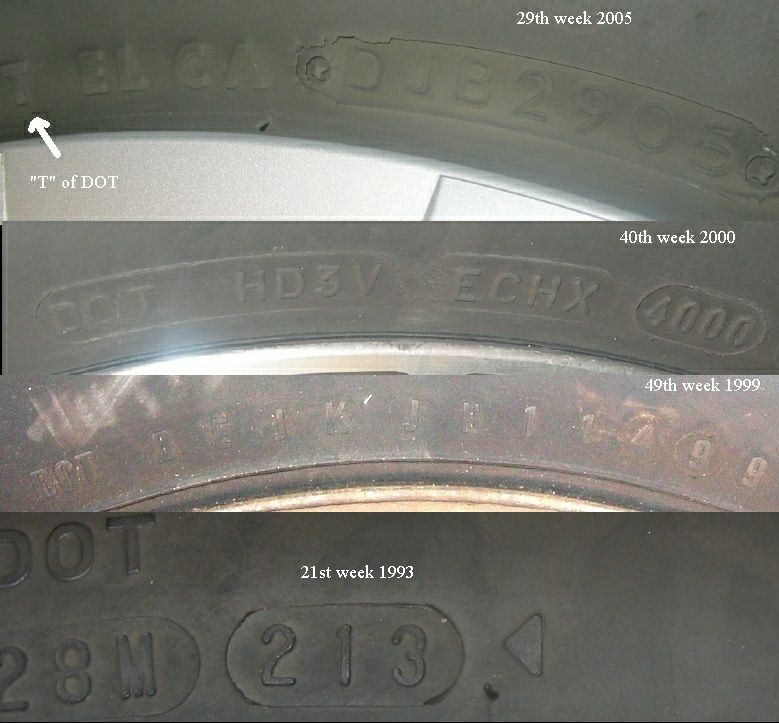
The pattern for tires made after 2000 is "WWYY" where "WW" is the week and "YY" is the year. Prior to 2000 it's "WWY". Note the date only appears on one side of the tire.
Here are some links to a sites I have found useful:
For you concours folks, try these sites for repro and whitewall tires:
The Datsun 510 Wheel and Tire FAQ Since the 510 shares its bolt pattern with the early Corvair, you can use the info to source wheels.
A primer for Shelby/Dodge FWD wheels
